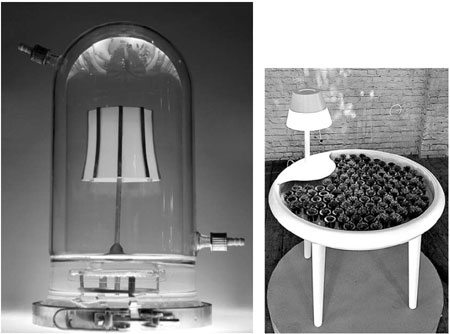Using the beauty of bacteria
Updated: 2013-01-27 08:27
By Julie Lasky(The New York Times)
|
|||||||
|
Household objects inspired or powered by biology: the Halflife lamp, left, relies on hamsters and fireflies; Moss Table's lamp is lit by bacteria feeding on moss compounds. Joris Laarman / Carlos Peralta and Alex Driver |
If we're to believe half a century of TV commercials, housekeeping is war - slaying bacteria, scraping away fungus and torturing mites. But the more peaceful idea that nature might be an honored houseguest is behind "Bio Design: Nature, Science, Creativity," a book published last month by the Museum of Modern Art.
Written by William Myers, a New York-based writer and teacher, "Bio Design" focuses on the growing movement to integrate organic processes in the creation of buildings and household objects so that resources are conserved and waste is limited. The book's 73 projects, culled from around the world, show how living trees can be coaxed into becoming houses and bridges; lamps can be powered by firefly luminescence; human DNA can change the color of petunias; and concrete, like skin, can heal itself.
We have been conditioned to fear micro-organisms, Mr. Myers said, "but in fact they can be useful and have been for millenniums, if you think about baking and brewing."
Designers habitually copy nature. The examples include things like Antonio Gaudi's soaring architecture, William Morris's floral wallpaper and George Nakashima's wood tables. Cutting-edge technology takes away nothing from nature-inspired designs, but instead enhances them. In 2006, the Dutch designer Joris Laarman introduced a chair modeled by computer along the principles of bone tissue development, so that the parts of the chair subjected to the greatest stress were thickest, while those subjected to the least were carved away. The result was an efficient use of material and a spectacular form.
Beyond form, bio design is also about harnessing the machinery of the natural world to perform as nature does: storing and converting energy, producing oxygen, neutralizing poisons and disposing of wastes.
Mr. Laarman's 2010 Halflife lamp is a good example. A prototype for a lampshade coated with hamster ovary cells modified with firefly DNA, it generates an enzymatic reaction that causes the lamp to light up, after a fashion, batteries not required. What the lamp does require is a continuous supply of nutrients to keep the cells alive.
"We're used to thinking we can throw away objects," Mr. Laarman said. "We're not used to objects you can care for or treat well, or that renew themselves."
Hamster ovary cells as pets? In the wonderland of biotechnology, bacteria is beautiful, moss is electric and decorative tiles are animated.
Consider Bacterioptica, a chandelier designed by Petia Morozov of Montclair, New Jersey, with petri dishes loaded with bacterial cultures nesting in a tangle of fiber optics. The pattern and color of the blooming bacteria (ideally supplied by family members and pets) change the quality of the light.
Or Moss Table, a collaboration between the scientists Carlos Peralta and Alex Driver of Britain and Paolo Bombelli of Italy, which exploits the small electrical current produced when certain bacteria consume organic compounds released by moss during photosynthesis. Using carbon fiber to absorb the charge, the scientists produced enough electricity with their table to power an attached lamp.
Then there is Growth Pattern, a series of ornamental tiles designed by the Seattle-based artist Allison Kudla, which spontaneously change their pattern because they are made of cut tobacco leaves laid out in a grid of square petri dishes. Steeped in a solution that behaves like a hormone, the leaves put out new growth.
An oddity of bio design is that the organisms brought into domestic environments often need to be protected rather than defended against. Marin Sawa, a London-based architect who manipulates the color of micro algae in flexible tubes to create a kind of living textile, describes the impulse to shield her samples from the destructive forces of a living space as "reverse thinking."
She explained: "I need them to be purely uncontaminated so that they can live and carry out photosynthesis, which is one of the most important biological systems of this planet." (Algae, she noted, produce almost half our oxygen.)
Still, bio designers must grapple with the Frankenstein factor: a concern that their experiments will unleash some unmanageable new horror.
Mitchell Joachim, who co-founded the architecture and urban design studio Terreform One in Brooklyn and runs a bio lab within its precincts, says he is paid regular visits by representatives from Homeland Security and the Federal Bureau of Investigation.
Mr. Joachim is part of a team responsible for developing the concept of living trees grafted together to create a domed shelter. He has also imagined a house made of living tissue - though he prefers the term "meat" - and is working on a chair made from a new compostable plastic that combines the root base of mushrooms with cellulose.
"When you're done with this chair," he said, "you don't landfill the thing. You throw it in the garden and it feeds other creatures. It's part of the web of life."
The New York Times
(China Daily 01/27/2013 page12)
